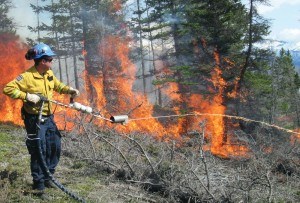
Jasper’s fire management team spent the weekend battling a pair of small wildfires in the northern part of the park.
Alberta fire officials first detected two blazes close to one another July 4 in the Smoky River Valley, in the northeast corner of the park near Willmore Wilderness Park.
Parks’ initial attack team started working with hand tools on the two 5000 square metre fires the evening of July 4, with support from a helicopter to help keep the blazes from spreading.
Parks representative Kim Weir said the terrain in that area of the park was “gnarly,” leaving firefighters to navigate complex cliffs and heavy debris. Also concerning were the extremely dry conditions, which meant the fires burned deep into the ground, and quite intensely.
“It’s so dry out there that the fire was burning very deep, and it was consuming moderate fuels, like a medium-sized tree trunk—and fully consuming it,” Weir explained.
By July 6 the Parks crew, aided by a pair of helicopters and an Alberta fire crew, had managed to douse one of the fires. According to Weir both fires had been extinguished as of July 7.
Weir said it was important that the fires were dealt with quickly, and weren’t allowed to spread, because they were located in the middle of caribou habitat. Caribou populations are extremely delicate in Jasper, but because the fires remained under control, Weir doesn’t think the A La Peche caribou herd will suffer.
Altogether, seven firefighters and two helicopters worked over the weekend to contain and extinguish the blazes, but because it is still quite dry, Parks will continue to monitor the sites for the next week or so, to ensure they don’t reignite.
“There’s a possibility that we will get some hotspots, but as of right now they are both extinguished,” she said. “We’ll be vigilant for ... quite a while, we expect.”
They will do this in part by bringing in a heat scanner, which will be used to search for hotspots from a helicopter circling the burn site.
Weir said that while these two fires were relatively harmless, Parks is bracing itself for the possibility of a lot of fire activity this year. She said that by some standards the park is dryer this year than it’s been since the notorious 2003 “year of fire.”
This June the park received only half the amount of rain it normally does, which is significant because June is generally a very wet month. This lack of precipitation only adds to the already dangerously dry season.
“It could definitely mean a hot, dry summer, and more potential for fire if we get the ignition sources,” Weir said.
Parks expects the fire index to remain at least high - more likely extreme - well into the foreseeable future.
Trevor Nichols
[email protected]
